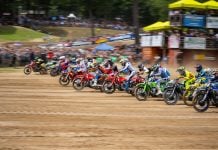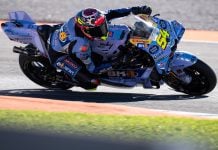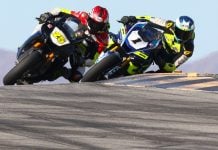Dressed To The Sixes: Inline 6-Cylinder BMW K1600GT and K1600GTL BMW went big with its newest entries into the luxury touring and sport-touring market the K1600GT and GTL which are powered by the first inline six-cylinder engine from a major motorcycle manufacturer in years. Unveiled last night amidst the ultra-cool collection of exotic motorcycles and cars at Jay Leno’s Garage in Burbank, the K1600s will be powered by a 1649cc powerplant. Why? “BMW has made the inline-six its own,” says Pieter de Waal, Vice President, BMW Motorrad USA, citing the layout’s torque, smoothness and unique sound. “Other manufacturers have made inline-sixes in the past with limited success. We believe we’ve met the challenges.” Honda, Kawasaki and Benelli all have dabbled with the design (matter of fact, an immaculate Honda CBX sat nearby, a part of Leno’s collection of bikes you wish you had). But none stuck with it for long; each quickly passed from the lineup. BMW’s approach built upon the successes and failures of the past, officials said. With the inherent smoothness of the design, no balance shafts were needed, saving weight and rotating mass. Further weight savings were found in using hollow assembled composite cams each camshaft is 2.2 pounds lighter than a conventional one, says Todd Anderson, Marketing Manager, BMW Motorrad USA. Narrowness came from using a relatively long-stroke 72mm by 67.5mm configuration with a 12.2:1 compression ratio from a four-valve-per-cylinder head. Advances in materials and cooling allowed the engineers to place the cylinder sleeves a mere 5mm apart. Borrowing a page from the CBX playbook, all engine ancillaries are placed behind the cylinder bank, above the gearbox. The engine utilizes an integrated dry sump, a triple-shaft gearbox, and inclines the cylinders at a 55-degree angle. The upshot is that the engine weighs approximately 226 pounds, and measures less than 22 inches across a figure comparable to that of the company’s large inline four-cylinder machines. And the extreme cylinder bank incline means that the bike is narrow where the rider’s knees need to be. BMW claims 160 bhp at 7750 rpm, 129 lbs.-ft. of torque at 5250 rpm, and redline at 8500 rpm. Not only that, but the company says the motorcycle goes 50 miles on a gallon of gas at highway speeds. Managing the engine’s output is an electronics suite that offers three power modes and a “dynamic” traction control system similar to that found on the S1000RR. The system, which features “a number” of gyroscopes, can be turned off. Suspension is conventional BMW Paralever single-shock system at the rear, dual longitudinal control arms with a single shock in the front. The bike is long, with a wheelbase of 1618mm (63.7 inches). Fully fueled, the GT weighs 703 pounds; the GTL, 767. Hauling all this to a halt is a pair of 320mm ABS-controlled discs at the front pinched by four-piston radial calipers, and a 320mm disc at the rear. Anderson made it clear that BMW intended for the GT and GTL to occupy very different segments of the marketplace. “It’s not like strawberry and strawberry banana. It’s like chocolate and vanilla. These are two very, very different motorcycles,” Anderson says. The GT very serious, with its blacked-out trim pieces is designed around the rider. The passenger is well, if they wanna sit back there, they can, but they’d better hang on tight. The focus on this bike is on the rider. The GT offers a stiffer rear suspension, a narrower, rounded seat to accommodate hanging off mid-corner, higher pegs and bars further forward. “It’s not a sofa. It’s a real motorcycle optimized for aggressive solo riding. This isn’t a showy bike; it’s a bike for getting from A to B really fast,” Anderson says. Dig through the detailed data of the media kit, and you find an optional Akrapovic sport silencer for the bike. Neat. The GTL which has its trim pieces chromed, and come standard with a trunk places much more emphasis on passenger accommodations. The handlebars are positioned 2-inches further back, the pegs 1-inch lower and further forward (and they are much larger, with a much bigger rubber footprint). The bike has softer rear suspension, a wider, flatter and lower seat, a larger windscreen and central locking for all bags. Each bike offers “adaptive” headlights that react to gyroscopic signals and level out during acceleration and deceleration, and turn into corners. Anderson has ridden the bike up canyon roads in the dark, and says, “It’s an absolute revelation. You ask “¦ why doesn’t every motorcycle have this?” In an attempt to cut down on the number of buttons on the handlebars and rider distraction BMW has created a multi-wheel controller that can be rotated forward or backward, shoved from side to side, or pushed straight in. A 5.7-inch LCD screen provides the rider with a massive array of information. For entertainment needs, the bikes are iPod, USB, and audio cable-ready to connect a choice of media delivery systems to the motorcycle’s audio system. The whole shootin’ match is BlueTooth compatible. The bikes should be available in late spring 2011. BMW has not yet set a price for the GT or GTL.
BMW Introduces New Six-cylinder Streetbikes At Jay Leno’s Garage
BMW Introduces New Six-cylinder Streetbikes At Jay Leno’s Garage
© 2010, Roadracing World Publishing, Inc.





